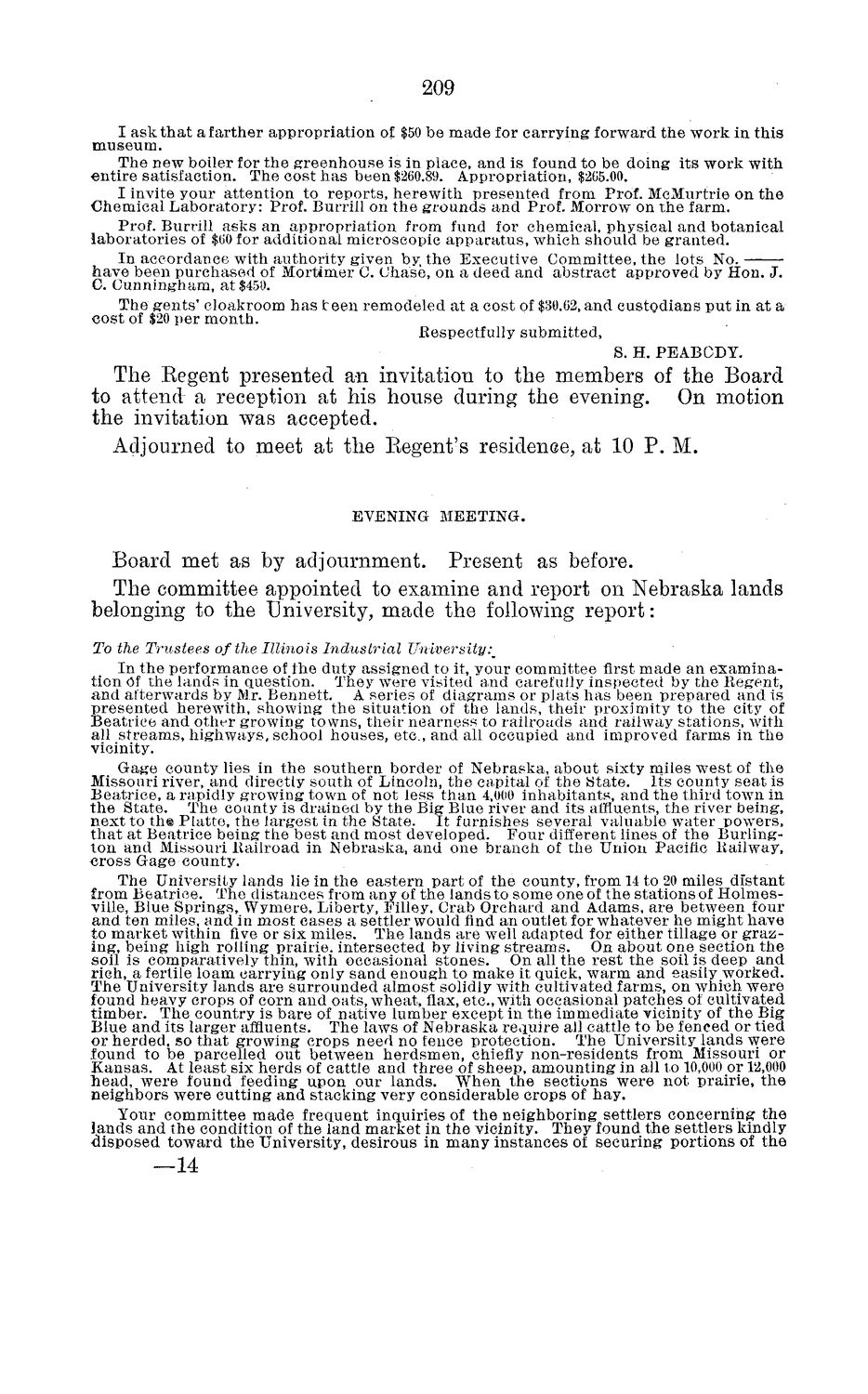| |
| |
Caption: Board of Trustees Minutes - 1884
This is a reduced-resolution page image for fast online browsing.

EXTRACTED TEXT FROM PAGE:
209 I ask that a farther appropriation of $50 be made for carrying forward the work in this museum. The new boiler for the greenhouse is in place, and is found to be doing its work with entire satisfaction. The cost has been $260.89. Appropriation, $2G5.00. I invite your attention to reports, herewith presented from Prof. McMurtrie on the Chemical Laboratory: Prof. Burrill on the grounds and Prof. MorrowT on the farm. Prof. Burrill asks an appropriation from fund for chemical, physical and botanical laboratories of $00 for additional microscopic apparatus, which should be granted. In accordance with authority given by, the Executive Committee, the lots No. have been purchased of Mortimer G. Chase, on a deed and abstract approved by Hon. J. C. Cunningham, at $450. The gents' cloakroom has teen remodeled at a cost of $30.62, and custodians put in at a cost of $20 per month. Respectfully submitted, S. H. PEABODY. The Eegent presented an invitation to the members of the Board to attend a reception at his house during the evening. On motion the invitation was accepted. Adjourned to meet at the Eegent's residence, at 10 P. M. EVENING MEETING. Board met as by adjournment. Present as before. The committee appointed to examine and report on Nebraska lands belonging to the University, made the following report: To the Trustees of the Illinois Industrial University:m In the performance of the duty assigned to it, your committee first made an examination O the lands in question. They were visited and carefully inspected by the Kegent, f and afterwards by Mr. Bennett. A series of diagrams or pJats has been prepared and is presented herewith, showing the situation of the lands, their proximity to the city of Beatrice and other growing towns, their nearness to railroads and railway stations, with all streams, highways, school houses, etc., and all occupied and improved farms in the vicinity. Gage county lies in the southern border of Nebraska, about sixty miles west of the Missouri river, and directly south of Lincoln, the capital of the State. Its county seat is Beatrice, a rapidly growing town of not less than 4,000 inhabitants, and the third town in the State. The county is drained by the Big Blue river and its affluents, the river being, next to tht Platte, the largest in the State. It furnishes several valuable water powers, that at Beatrice being the best and most developed. Four different lines of the Burlington and Missouri Railroad in Nebraska, and one branch of the Union Pacific llailway, cross Gage county. The University lands lie in the eastern part of the county, from 14 to 20 miles distant from Beatrice. The distances from any of the lands to some one of the stations of Holmesville, Blue Springs, Wymere, Liberty, Filley, Crab Orchard and Adams, are between four and ten miles, and in most cases a settler would find an outlet for whatever he might have to market within five or six miles. The lands are well adapted for either tillage or grazing, being high rolling prairie, intersected by living streams. On about one section the soil is comparatively thin, with occasional stories. On all the rest the soil is deep and rich, a fertile loam carrying only sand enough to make it quick, warm and easily worked. The University lands are surrounded almost solidly with cultivated farms, on which were found heavy crops of corn and oats, wheat, flax, etc., with occasional patches of cultivated timber. The country is bare of native lumber except in the immediate vicinity of the Big Blue and its larger affluents. The laws of Nebraska require all cattle to be fenced or tied or herded, so that growing crops need no fence protection. The University lands were found to be parcelled out between herdsmen, chiefly non-residents from Missouri or Kansas. At least six herds of cattle and three of sheep, amounting in all to 10,000 or 12,000 head, were found feeding upon our lands. When the sections were not prairie, the neighbors were cutting and stacking very considerable crops of hay. Your committee made frequent inquiries of the neighboring settlers concerning the lands and the condition of the land market in the vicinity. They found the settlers kindly disposed toward the University, desirous in many instances of securing portions of the —14
| |